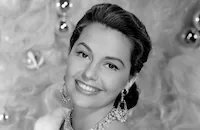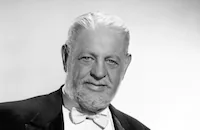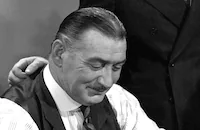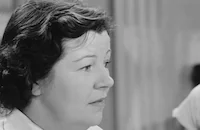The Unfinished Dance

Brief Synopsis
Cast & Crew
Henry Koster
Margaret O'brien
Cyd Charisse
Karin Booth
Danny Thomas
Esther Dale
Film Details
Technical Specs

Synopsis
Meg Merlin, a young ballerina studying at the Ballet School of the Metropolitan Opera Company in New York, would rather spend hours at a time watching the dance movements of her idol, Ariane Bouchet, than attend her classes. Meg's lack of enthusiasm for her classes nearly results in her dismissal from the school by her teacher until the kindly Mr. Paneros, a friend of Meg's aunt, intervenes. One day, during rehearsals, Meg learns that the school has hired the famous ballerina Lady Anna La Darina, known by many as "The First Lady of Ballet." Mistakenly believing that La Darina has arrived to replace Ariane, Meg undertakes to humiliate the new dancer and sabotage her attempt to settle into the school. She begins her campaign by turning off the lights when a photographer tries to take Ariane and La Darina's photograph. Later, when Phyllis Brigham, another young dancer, tells Meg that she prefers La Darina to Ariane, Meg strikes her. Meg is severely reprimanded for her assault on Phyllis, but she continues her campaign against La Darina nevertheless. During a performance of "Swan Lake," Meg, intending to pull the light switch on La Darina's solo sequence, accidentally hits the trap door switch instead, and sends the dancer falling through the stage. A physician later determines that the damage to La Darina's spine as a result of the fall is so extensive that she will likely never dance again. Though Meg has decided to keep her misdeed a secret, Phyllis and her friend, Josie Devore, suspect that Meg is the culprit and blackmail her. Time passes, and Ariane, who is revealed to be selfish and devoted more to clothes and fame than ballet, proves herself a poor idol for Meg. After Ariane decides to leave the company to marry, La Darina eventually returns to the school as a ballet supervisor and takes a special interest in Meg's promising talents. As Meg and the kind La Darina strike a friendship, Meg makes a number of unsuccessful attempts to confess her responsibility for La Darina's crippling fall. One day, Josie, jealous of the attention that Meg is gettting from La Darina, reveals Meg's secret. When Meg learns that she has been exposed, she runs out of the school seeking a quiet place to hide in shame. Mr. Paneros eventually finds Meg, and she tearfully confides in him. After Mr. Paneros tells La Darina about Meg's confession, La Darina forgives her.

Director

Henry Koster
Cast

Margaret O'brien

Cyd Charisse
Karin Booth
Danny Thomas
Esther Dale

Thurston Hall
Harry Hayden
Mary Eleanor Donahue
Connie Cornell
Ruth Brady
Charles Bradstreet
Ann Codee

Gregory Gay

Connie Gilchrist
Wilson Wood
Dorothy Neumann
Jimmy Dietrich
Tim Ryan
George Zoritch
Jane K. Loofbourrow
Paul Newland
Norman Leavitt
Sid D'albrook
Edward Kilroy
Tom Dillon
Robert E. O'connor
Dutch Schlickenmayer
Rose Langdon
Celia Travers
Anne O'neal

Addison Richards

John Hamilton

Nella Walker
Barbara Billingsley
Rhea Mitchell
Lola Deem
Pat Emery
Alice Wallace

Marie Windsor
Frieda Stoll

Max Linder
Eloise Hardt
Phil Dunham
Jessie Grayson

Edward Keane
Polly Bailey
Dick Earle
Paul Kruger
Mary Stuart

Margaret Bert
Crew
Douglass Biggs
Daniel B. Cathcart
Myles Connolly
Jack Dawn
Sammy Fain
Cedric Gibbons
Hugh Hunt
Irene
Henri Jaffa
Natalie Kalmus
Henry Koster
David Lichine
Joe Pasternak
Lothar Perl
Helen Rose
Douglas Shearer
Julian Silberstein
Herbert Stothart
Robert Surtees
Peter Ilyich Tchaikovsky
Edwin B. Willis

Photo Collections
Film Details
Technical Specs

Articles
The Unfinished Dance
The Unfinished Dance was based on Jean Benoit-Lévy's 1937 French film, La mort du cygne (released in the U.S. as Ballerina). In her study of ballet on film, Dying Swans and Madmen (2008), Adrienne McLean writes that MGM bought the rights to La mort du cygne and pulled the original from circulation when they decided to make The Unfinished Dance, which sets the action at the Ballet School of the Metropolitan Opera in New York. Student Meg Merlin (Margaret O'Brien) idolizes ballerina Ariane (Cyd Charisse). When Meg learns that the famous ballerina La Darina (Karin Booth) is joining the company, she mistakenly believes La Darina will replace her idol. Meg's obsessive devotion to Ariane and hatred for La Darina lead to disaster, and she is tortured by the consequences of her actions.
According to O'Brien, her mother, a former dancer, had seen the French film and brought the idea of remaking it to MGM. The 9-year old Margaret trained for six months with Russian ballet teachers, and did her own dancing in the film. Director Henry Koster had experience working with young performers--the German émigré had begun his American career directing Deanna Durbin musicals at Universal for producer Joe Pasternak--and had gone with Pasternak to MGM. Koster thought O'Brien was talented, and liked working with her. His problem was with O'Brien's mother, who sat behind him during takes, and gave Margaret signals when she wanted another take. But overall, Koster was happy with O'Brien's performance. He was less impressed with Karin Booth, a former model who was playing her first leading role after years of playing bit parts. Booth couldn't dance, and Koster had to use a double for her dancing wide shots. For the close-ups, he built a rotating platform to spin her around. Koster also thought Booth lacked acting ability, and her subsequent career appears to support his judgment. She appeared mostly in b-pictures for the rest of her career, and retired in 1959. But in The Unfinished Dance, her impassive beauty and uninflected emoting lend an appropriate remoteness and hauteur to her character.
Cyd Charisse's acting skills were also limited, but she more than made up for it with her spectacular terpsichorean talent. Trained in classical ballet, Charisse danced with the Ballet Russe de Monte Carlo while still a teenager. Ballet Russe dancer and choreographer David Lichine gave Charisse her first film dancing role in the 1943 musical Something to Shout About, and MGM signed her in 1945. Lichine was the choreographer for The Unfinished Dance, and his ballets are a great showcase for Charisse. Throughout the late 1940s, Charisse played supporting roles, but most of the films she appeared in featured dance numbers that gave her an opportunity to shine. By the early 1950s, she was one of MGM's top musical stars.
Comedian Danny Thomas made his film debut in The Unfinished Dance, playing O'Brien's guardian. It was a warm and appealing performance, and the two would be reunited the following year in Big City (1948). But Thomas's film career never really took off. When he turned to television in the early 1950s he became a huge star.
Critics compared The Unfinished Dance unfavorably to the French original. Bosley Crowther of the New York Times called it "a big splash of show-off theatre, in which the story is as slickly decorative as are the elaborately staged ballets," and sniped at O'Brien, "trotted out often to poise on her hastily tutored toes to add her particular brand of cuteness to some specially manufactured ballets." Time magazine, after a snarky plot summary that gave away all the film's twists, concluded the review with one more bit of snark: "All ends with little Margaret, wistful as a hand-painted freckle, watching Cyd & company execute what seems to be a ballet interpretation of the Birth of the Universe." Highbrow critics could sneer all they liked, but lowbrow (and even middlebrow) movie fans liked it just fine. Seen more than sixty years later, The Unfinished Dance is definitely not High Art, nor does it pretend to be. It is a high-gloss example of another kind of art, that of the MGM musical, and an opportunity to see one of the era's finest young actresses giving one of her most emotional performances.
Director: Henry Koster
Producer: Joe Pasternak
Screenplay: Myles Connolly, from the story by Paul Morand
Cinematography: Robert Surtees
Editor: Douglass Biggs
Costume Design: Irene, Helen Rose
Art Direction: Cedric Gibbons, Daniel B. Cathcart
Music: Herbert Stothart
Principal Cast: Margaret O'Brien (Meg Merlin), Cyd Charisse (Mlle. Ariane Bouchet), Karin Booth (La Darina), Danny Thomas (Mr. Paneros), Esther Dale (Olga), Thurston Hall (Mr. Ronsell), Harry Hayden (Murphy), Mary Eleanor Donahue (Josie), Connie Cornell (Phyllis).
C-101m.
by Margarita Landazuri

The Unfinished Dance
Quotes
Trivia
Notes
The working title for this film was Ballerina. The picture marked the screen debut of Danny Thomas, and was the first film in which Karin Booth, born Katharine Hoffman and formerly known as Katharine Booth, was billed under her new name. Although a May 1946 Hollywood Reporter news item noted that dancer Katherine Sergava was tested for a role, she did not appear in the released film. Another film based on Paul Morand's novel was the 1937 French film La mort du cygne, directed by Jean Benoit-Lévy and starring Yvette Chauviré and Mia Slavenska. The 1937 film was released in the United States under the title Ballerina.















